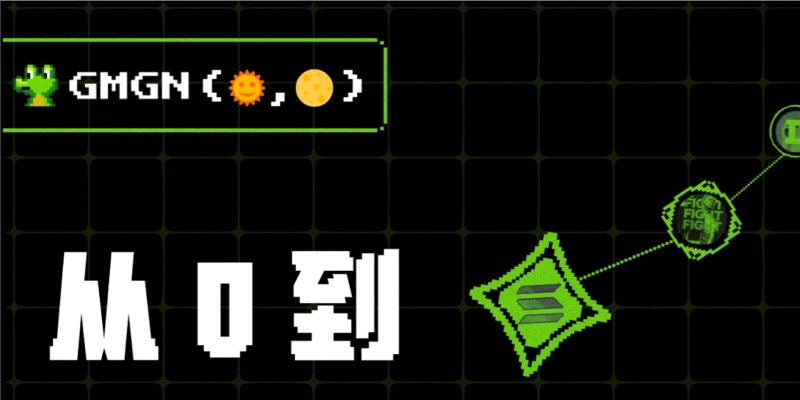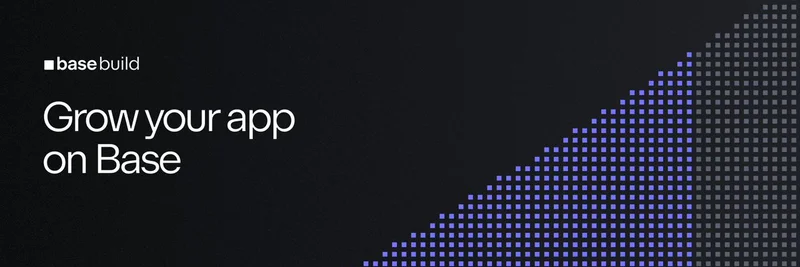Chapter 1: 🆕 Getting Started - GMGN Basics
Section 1: On-Chain Fundamentals
1.1 What are On-Chain Assets?
On-chain assets are those created on the blockchain through token generation events (TGEs). This includes both meme tokens and project tokens with development teams. These assets often have strong community attributes because the community participates in both the price discovery process (low market cap phase) and the value creation process (market cap growth).
Why do communities form?
On-chain projects are often created by small teams. When ordinary users can acquire tokens at low prices, they are motivated to help the project to increase the value of their tokens. This common goal unites them and forms a community. Building a community involves promoting the project with the aim of raising the token value or achieving product milestones.
1.2 Why Play On-Chain Assets?
One of the underlying business models in crypto involves asset issuance. In the traditional process, from team formation to venture capital investment and finally listing on exchanges, the most significant profits are reaped by numerous intermediaries. This model has become increasingly unsustainable since the end of the last cycle because retail investors are at the bottom of the chain with little chance of profit. However, the issuance of on-chain meme assets changes this dynamic.
The advent of Pump.Fun has drastically reduced the barriers to asset issuance, improved efficiency, and offered retail investors the opportunity to acquire tokens at low prices (below $100,000 market cap).
The memecoin sector is experiencing explosive growth. Opportunities are primarily emerging on the Solana blockchain, which has shown significant wealth generation, sufficient liquidity, and the potential for projects to rise from under $100,000 to upwards of $1 billion in market cap. Both short-term speculative trades and medium-to-long-term asset allocation strategies are viable.
From November 2024 to the end of January 2025, the total market capitalization of the memecoin sector increased from $40 billion to $120 billion. The influx of capital and new investors, as well as the current rapid growth trend, all indicate that memecoins are one of the biggest trends and growth sectors this cycle. The trend has become global since Donald Trump issued a memecoin. A new era of asset issuance and trading is upon us.
Section 2: Getting Started
2.1 Why Learn to Participate On-Chain?
The market is structured like a dumbbell:
- High wealth generation is found in the top-tier assets like BTC and SOL, and in long-tail on-chain memecoins.
- Traditional exchange-listed altcoins (VC coins) struggle to increase in value, often exhibiting a "listing and then dumping" pattern.
Explosive growth opportunities:
- Many wealth-creation stories are appearing on Solana; memecoins are driven by sentiment and can experience rapid short-term surges.
- On-chain memecoins can reach market caps of $1 billion or more, with $Trump even reaching tens of billions. There are investment opportunities across different time horizons.
New sectors and trends:
- DeFi summer, the issuances of memes on various public chains, the BTC ecosystem, and AI agent coins all originated on-chain. These trends represent new wealth-generating opportunities in crypto. It is essential to understand and participate in these trends, or you risks falling behind the current market cycle.
2.2 Can You Really Get Rich On-Chain?
Because low-priced tokens exist and current market cap ceilings for on-chain projects are not low, there are many instances of life-changing wealth generation on-chain. However, low market cap assets are incredibly risky and can easily go to zero. Making profit requires trial and error (and losses), as well as considerable time and effort to learn and practice. It is not advisable to start with large capital, but instead to begin with small amounts to test the waters and gradually progress.
2.3 Basic Operations
Here's a step-by-step guide on how to transfer crypto from a centralized exchange to an on-chain wallet, and how to make your first trade on GMGN.
2.3.1 Recommended Setup
For on-chain trading, it’s ideal to use a computer. Analyzing more information is necessary compared to trading on centralized exchanges. Price charts are just a small part of it. Once you get started, you will need to analyze on-chain data, track community developments, and identify hot tokens. This process is difficult if you are using only a phone. Moreover, on-chain trading is about securing low-cost tokens, and the use of Telegram to connect to GMGN and make smart contract transactions is favored by those looking to increase their likelihood of success.
2.3.2 How to Log In and Deposit on GMGN
Visit gmgn.ai. Click “Connect” in the upper right corner of the website. A window will appear. Click to connect via Telegram.

After clicking the Telegram connect button, the following window will pop up:
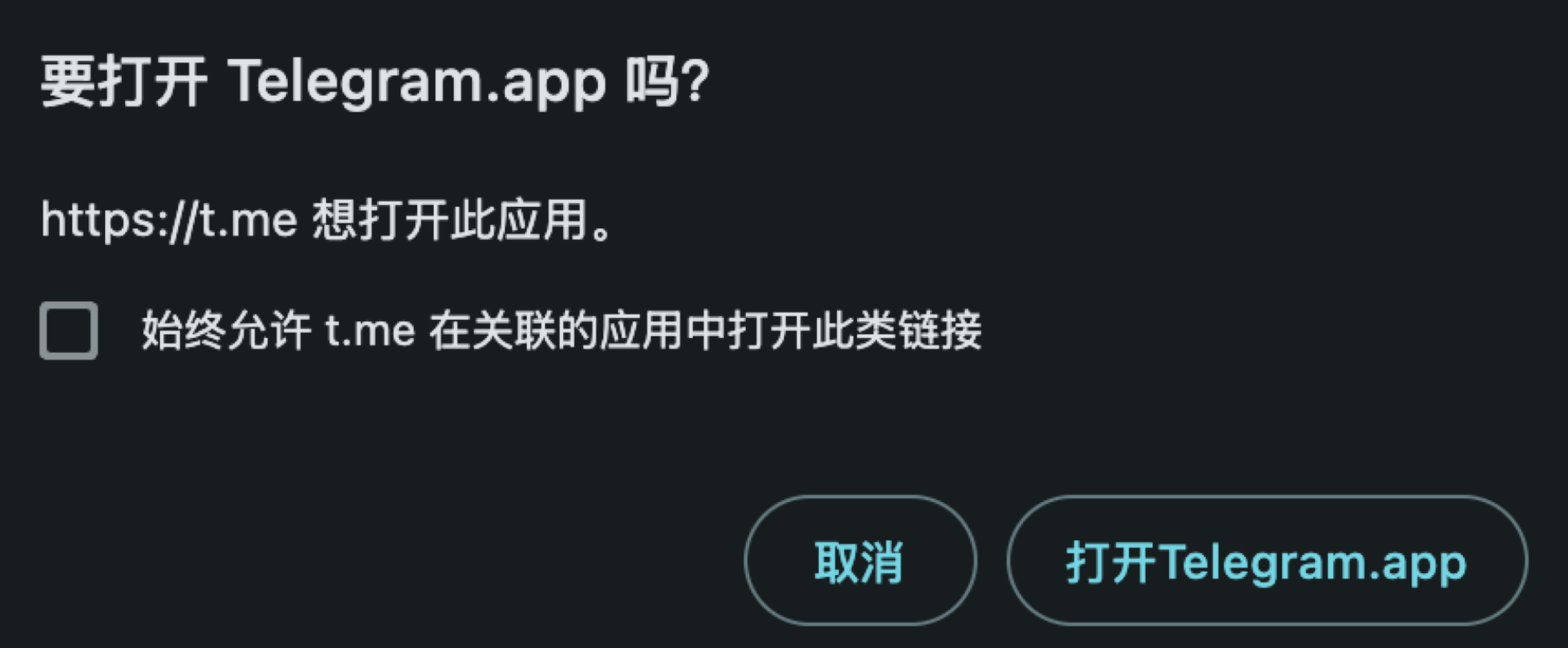
This is the GMGN AI TG BOT. Click to open Telegram.
You'll see information showing your Solana, Ethereum, and Tron wallet addresses, which correspond to your Solana, ETH, and Tron wallet addresses respectively.
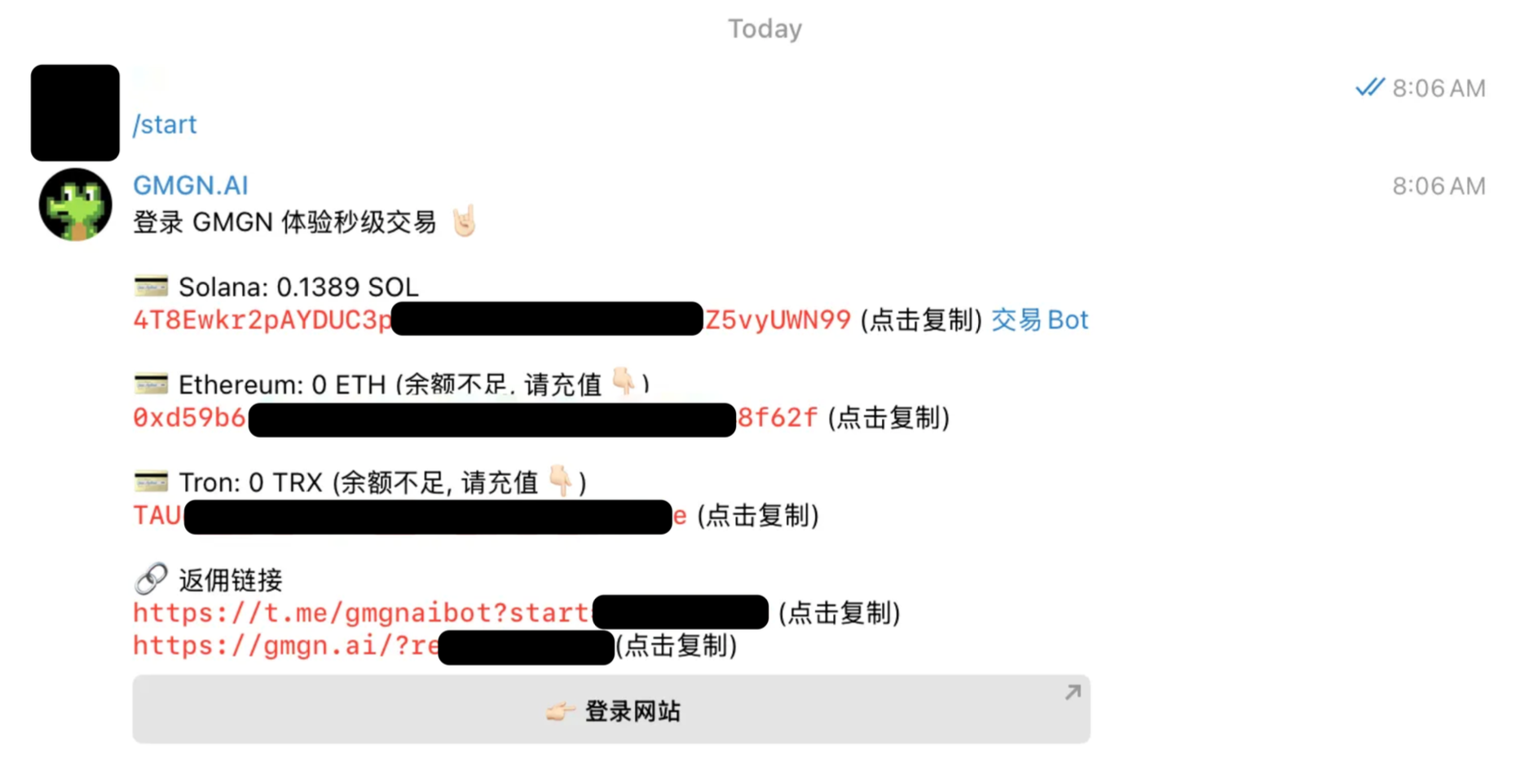
You'll also see your referral link to share with your friends. It is recommend using the link starting with t.me.
Now you can log in to the website. An "Open Link" prompt will appear; simply click "Open" to confirm.

After logging in successfully, you will see the following in the upper right corner:

2.3.3 Transferring Crypto from Exchanges and Depositing into GMGN
Purchase SOL on a centralized exchange and then withdraw it to your GMGN wallet address. Click on the small icon (indicated by the arrow) to copy your deposit address. Paste this address into the withdrawal address field on your exchange and transfer a minimal amount first to ensure everything is functioning correctly. Once you are comfortable with the process, then you can proceed with larger transactions.

2.3.4 Make Your First Trade and Enter This New World!
After depositing SOL into your wallet, let’s take $TRUMP as an example and conduct a buy and sell transaction. Visit gmgn.ai, click “Connect“ in the upper right corner, select “Connect Telegram” and log in successfully.
Select "Search Token / Wallet" in the middle, enter "trump," and select the token that appears.
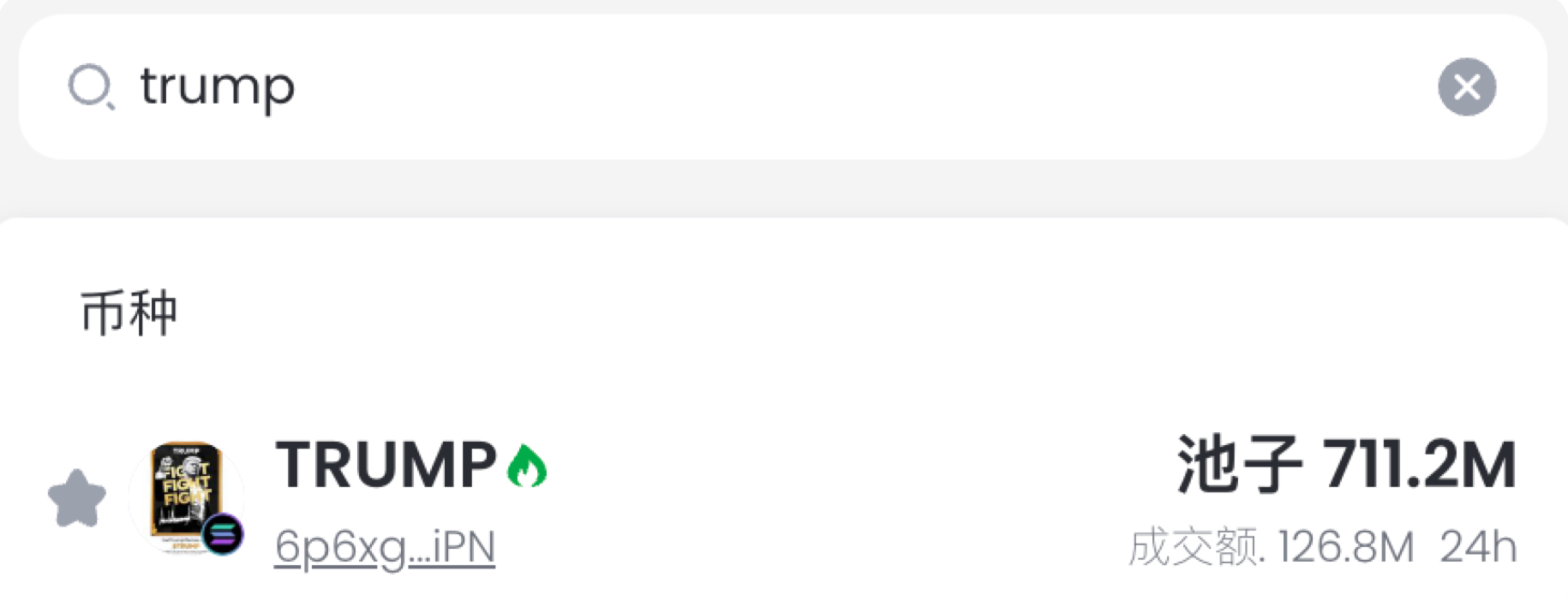

Buying
- Before buying, click the first triangle arrow in the bottom right to set "Anti-MEV Mode" in the drop-down menu.
- Click "Buy" on the right, enter the quantity you wish to buy (e.g., 0.1 SOL), and click "Buy" again.
Selling
- Click "Sell" tab on the right, select "100%", and click "Sell".
- Congratulations, you have now successfully completed your first on-chain trade!
Notes:
Slippage
- Slippage is the percentage difference between the price you expect and the actual price you get during a trade. Setting the slippage too high makes you vulnerable to arbitrage bots; conversely, too low of a setting may prevent the transaction from completing, especially during volatile periods.
- The recommended setting of 0.5% should work well in stable market times.
- When trading a hot token, it is usually best to set the slippage rate to 10% in order to ensure a successful buy order goes through.
MEV/Arbitrage Bots
- When trading on-chain, you will often encounter arbitrage bots, also known as "sandwich" bots.
- What does that mean? If you don't set up your trade properly, these bots will buy before you and sell immediately after your purchase, "sandwiching" your buy order. This will show up as a long wick on the candlestick chart.
- Here's an example of a $ACT purchase that was attacked by the sandwich bot: The buyer purchased the token for approximately 0.04, while the price was originally at 0.023.
- How to deal with this: Firstly, set a reasonable slippage rate. Set it at 10% when trading hot tokens, but remember to revert back to 0.5% (or similar rate) during regular times; secondly, activate "anti-MEV protection" or "anti-sandwich" mode in GMGN to avoid bot attacks.
AMM Pools/LP
- These are fundamental concepts in DeFi. Unlike the order book system used by centralized exchanges, on-chain transactions aren't a direct exchange between buy and sell orders. Instead, each transaction occurs against liquidity pool (also known as an automated market maker). When you purchase a token, you are buying from the pool; when you sell, you're adding your tokens to the pool, this is known as an AMM pool.
- Using $ACT as an example, you can see that the pool contains $930,000 worth of $ACT and $930,000 in $SOL. Every buy order you make adds more $SOL to the pool and extracts $ACT (increasing the $ACT price), and every sell order returns $ACT to the pool to get $SOL in return (decreasing the $ACT price).
- LP's, or liquidity providers, add both $ACT and $SOL to the liquidity pool at a ratio based on the current price. Liquidity providers are subject to impermanent loss risk and earn a portion of trading fees, which is commonly referred to as adding to the liquidity pool.
Section 3: From Scanning to Sitting
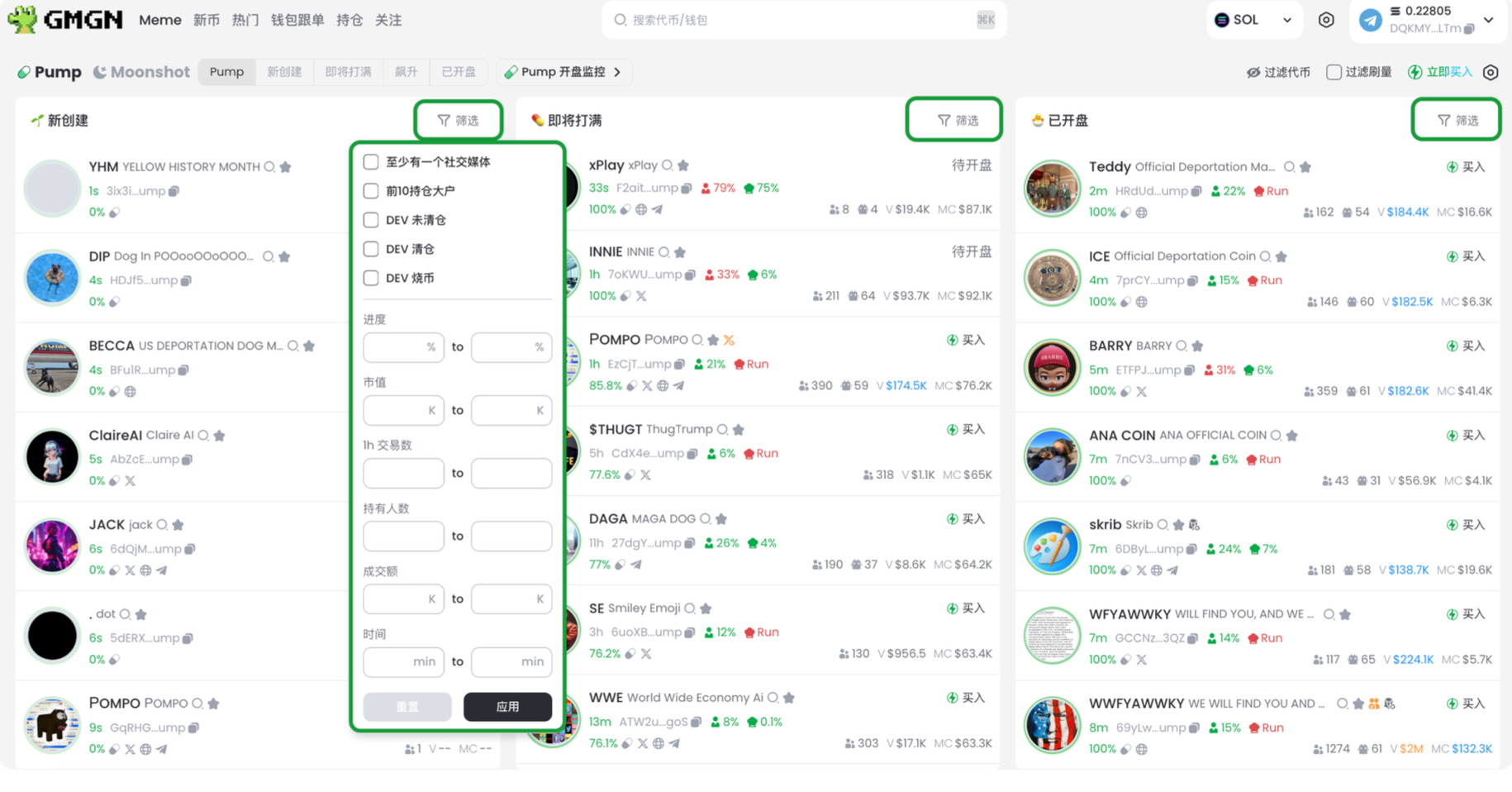
3.1 Scanning the Chain is a Must for Any Meme Trader, Starting from an Overall Scan
- Open the GMGN - Pump page. You will find three sections: "Newly Created", "Filling Up", and "Launched". Each of these pages includes a filter option in the upper right corner.
- On the SOL chain, thousands of new tokens are generated daily, with most being scam, copy, or otherwise worthless. Learning to filter out the trash by properly applying GMGN’s settings will cut out a lot of noise and be critical to your success.
- Under "Newly Created", you'll want to focus on market cap, trading volume, and at least one social media signal. For example, filter for a market cap greater than 20K to remove trash; a trading volume greater than 100 trades to remove inactive projects; and ensure to look for at least one social media presence to check the project's background, if the narrative is strong enough, and if the project has enough potential.
- Under "Filling Up", focus on market cap, creation time, and the distribution of the top ten holders. For example, filter for a market cap greater than 50K. Look at creation time as most successful tokens hit cap within 5 minutes, unless they're a token that just got a second wave. Evaluate the top 10 holders by reviewing the bubble chart and holders page so as to not get caught up in a project where the top holders are associated with each other or look suspicious, potentially an easy rug scenario.
- Under "Launched", continue to prioritize market cap, aiming for at least 100K–200K, as many dump after listing on exchanges. Many scams will also pump and then rug, prioritize reviewing the token holder information to evaluate the distribution as trading volume can be easily faked, and market cap can easily be manipulated.
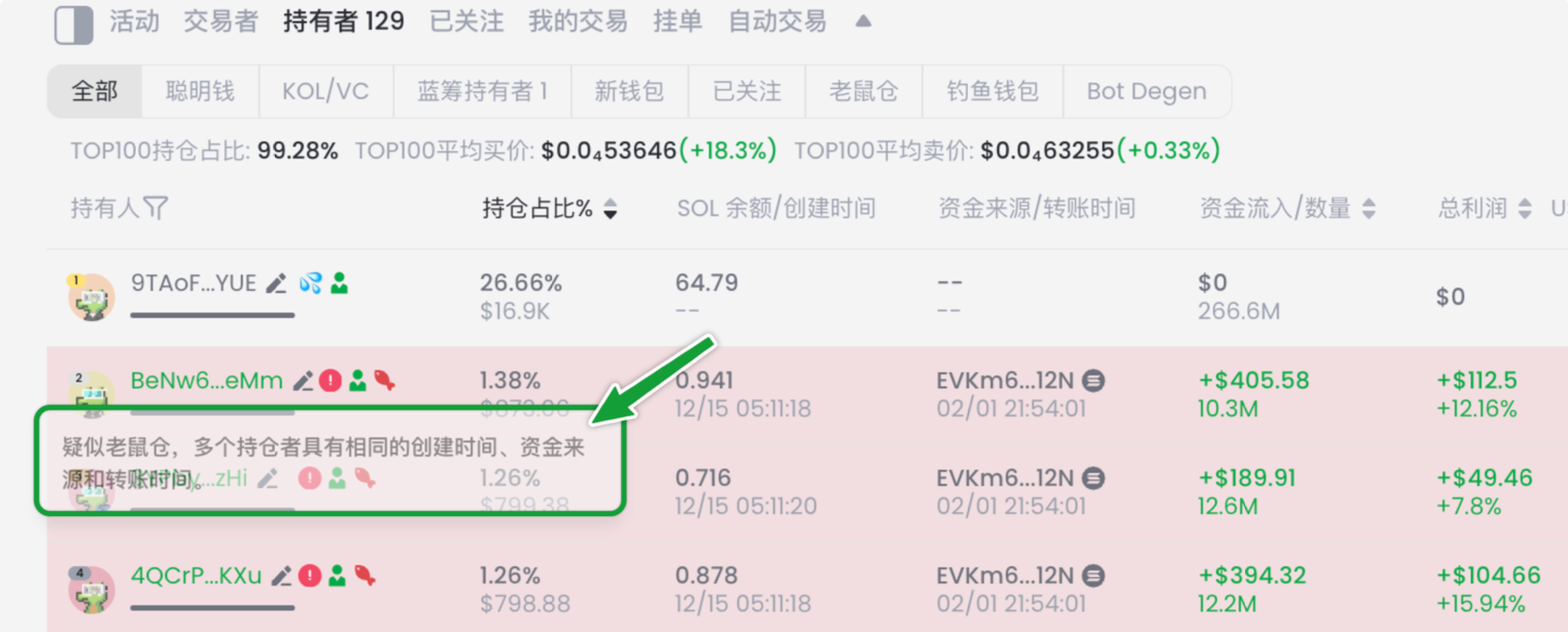
3.2 When You Find a Token of Interest, Start Checking its Information
Firstly, check social media including Twitter, Telegram, and the project's website (be aware of phishing attempts), and check to see if there's any substance or value to the project. Further, check their follow list and followers to see if any institutions, well known projects or KOLs are following them.

- Click on the name and contract to jump to Twitter and search to gauge market sentiment, find any of those who found the token early who you might want to follow. Contract search is generally better, compared to name search, due to the token's unique identity.

- If the creator of the token has launched other tokens, their likelihood of rugging can be assessed by looking at the number of tokens they have released. Those who launch many are more likely to rug than those who launch a select few.

3.3 How to Build an Address Database (For Clarity and Understanding)
Chain scanning not only involves token selection; it also focuses on building a personal database on-chain with clearly defined wallet address categories. By monitoring the transaction information of these wallets, you can quickly grasp current market trends. Use GMGN’s "Following", "APP," and "Telegram Notification Bot" to monitor wallets and receive trading notifications. Regularly updating the address database, along with reviewing and analyzing results will be key to refining your strategies.
- Categorize addresses by type: narrative-following "diamond hand," big player, KOL-linked trend addresses, etc.
- Categorize by specific trading activity: address who can consistently profit from the fastest pumps, those who buy during a dip, and so on.
How to build a personal on-chain address database?
- Tag the early money from successful projects: In the transaction history of high-performing projects, note the addresses of early high-profit wallets and monitor their activity for reference.
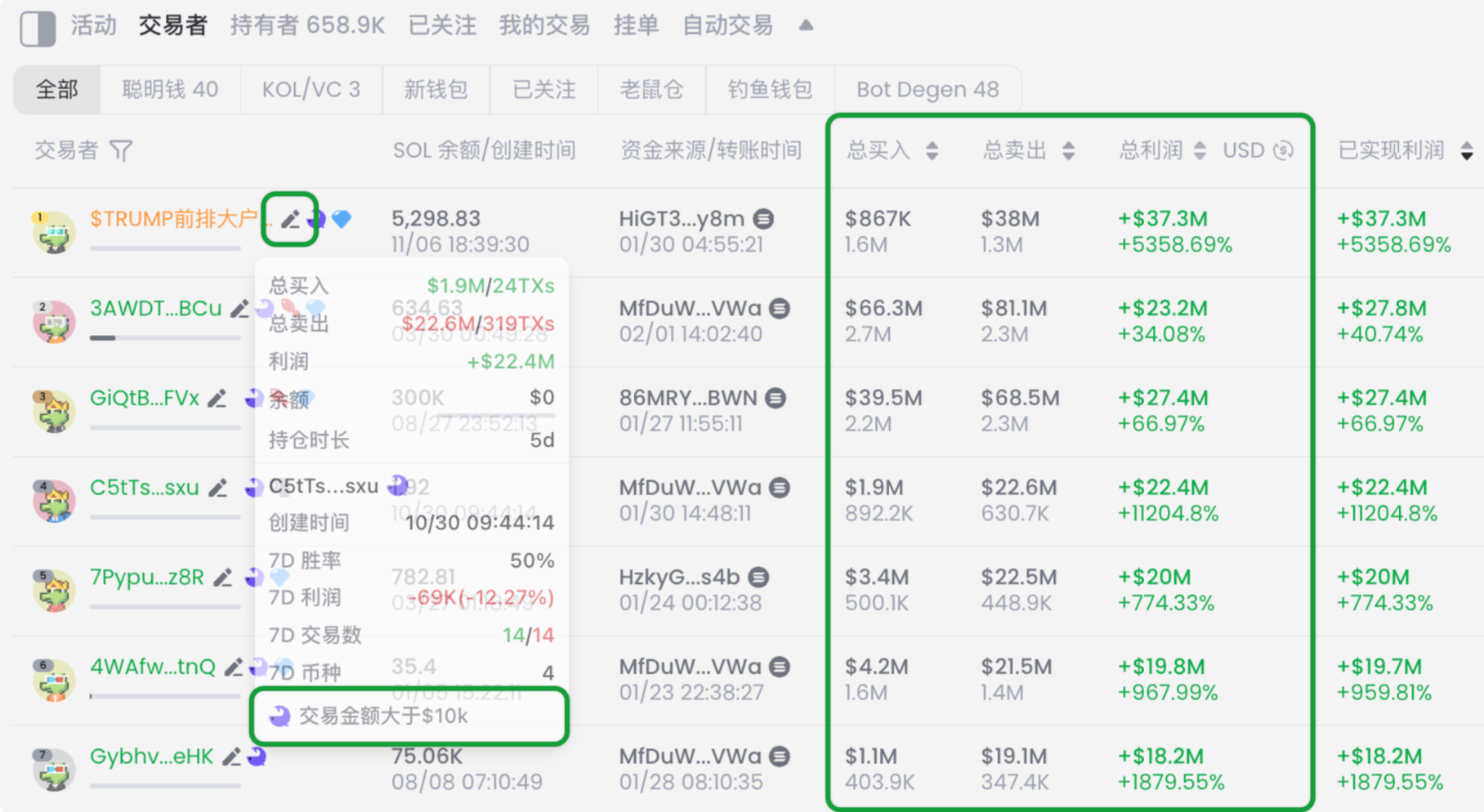
- Tag known KOLs: Search for known KOLs by name in the GMGN search bar and follow them to stay updated on trends.
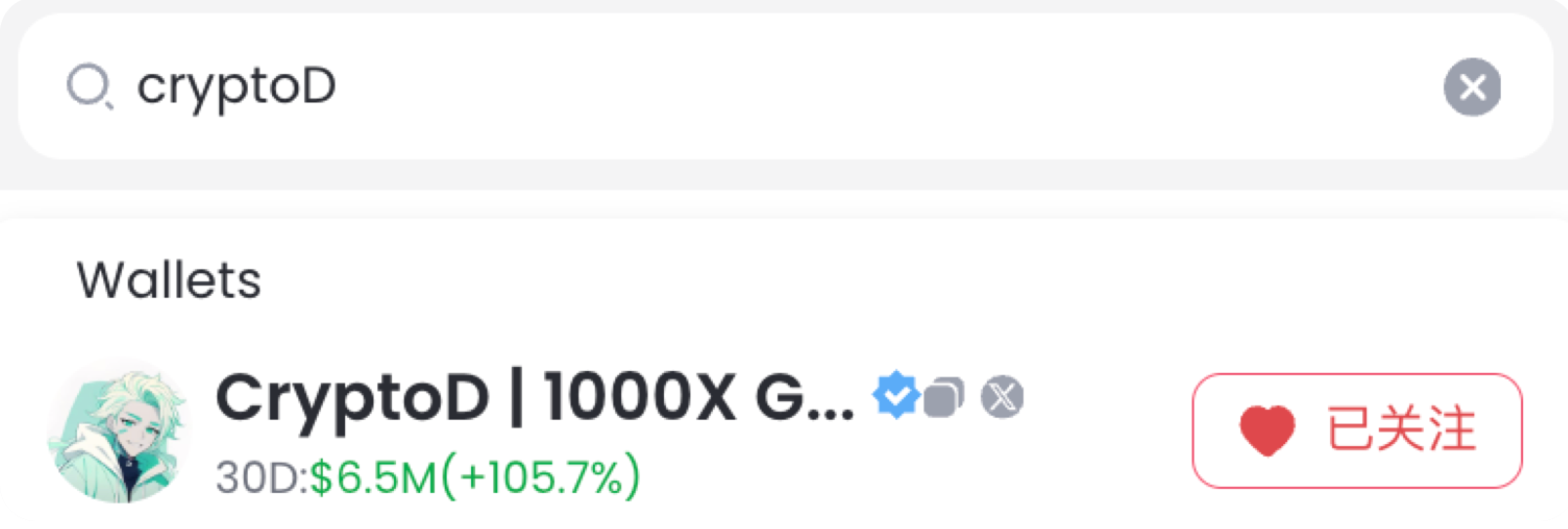
- Tag high-profit smart wallets on-chain: Find high-profit smart money wallets on the "Copy Trading-Leaderboard." Analyze their trading styles and then follow and categorize them to continuously monitor their activity.

Tag project owners/market makers' addresses: Large amounts of money flowing in at key moments can be indicative of the addresses of the project owners/market makers. They exhibit a number of traits:
- They will put it all in in one go.
- Large amounts of capital will constantly flow through their wallets.
- They use bots to make many transactions simultaneously across different kinds of tokens.
The behaviors of project owner/market maker addresses and ordinary wallets are very different during recent transactions.
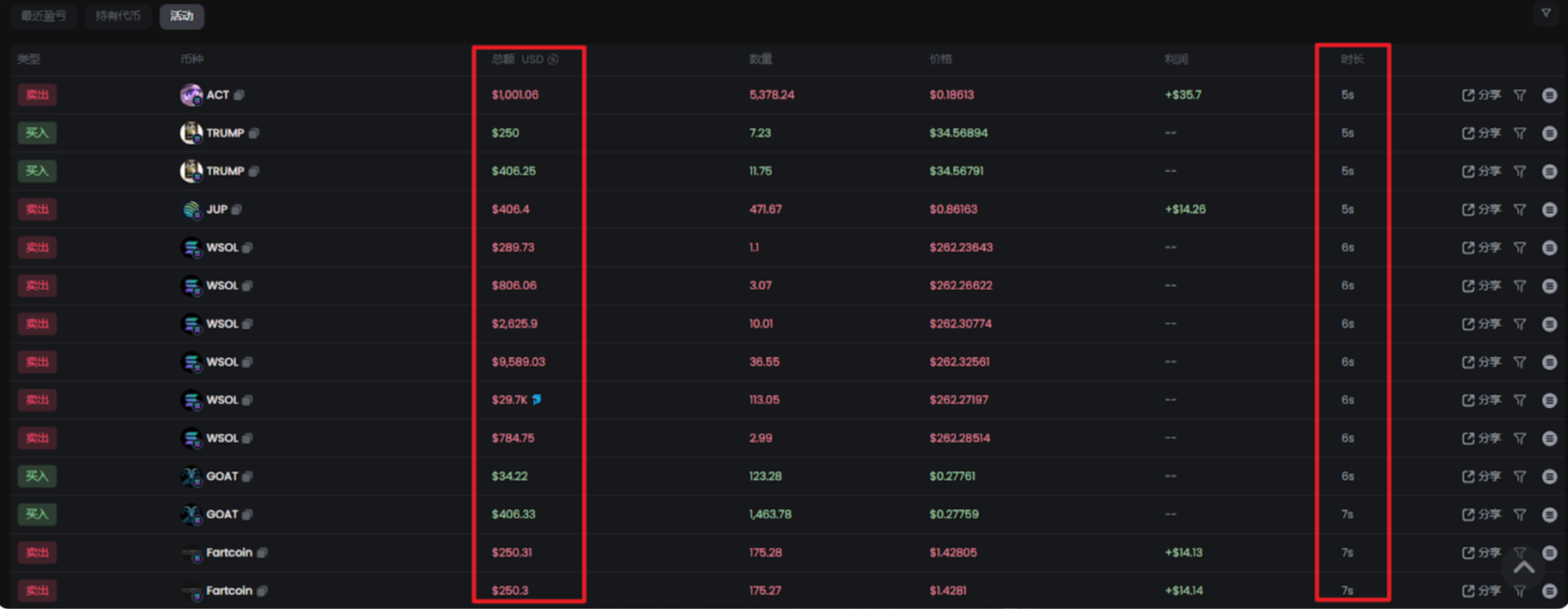
- Teamwork: Use an address with shared private keys among your team. After setting this up, the following list will appears under your "Following" tab in GMGN:
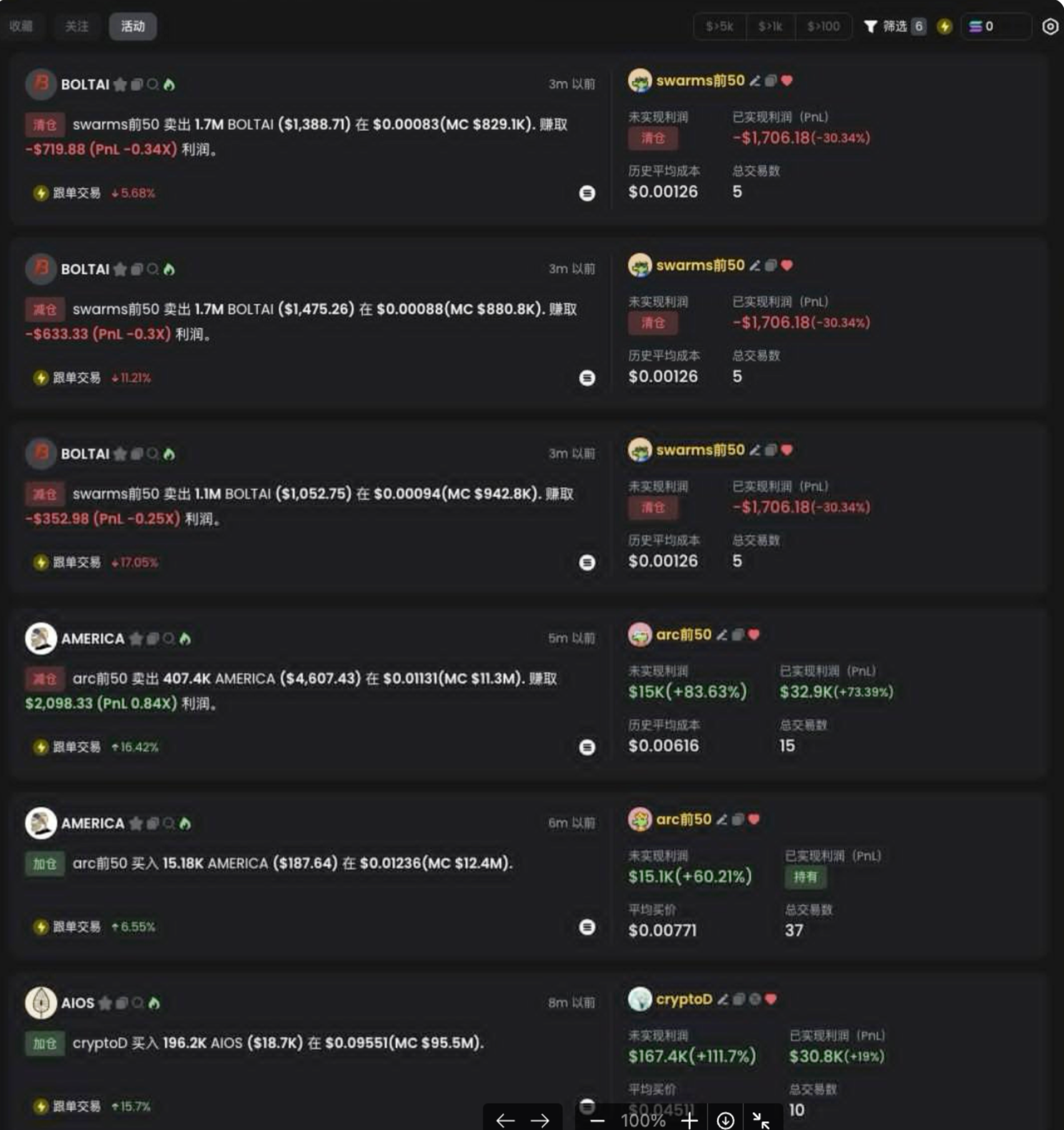
3.4 Advanced Address Collection: How to Determine Token Structure/Project Owner
Types of Project Owners
- Project owner wallets: Used for accumulation.
- Market-making wallets: Increase trading volume with repeated buying and selling.
- Wild project owner: Used for project ownership on a popular token.
Analysis of Project Owner Characteristics
Project owner’s wallet addresses will likely appear in the top 100 token holders. Focus on tracking the top 100, particularly when project are consolidating as it might be project owners accumulating tokens.
The number of transactions is a trait of market-making wallets. They exist to profit from higher prices and also serve to build support at the lows. In addition, they slowly transfer the project's tokens to diamond hands and large investors to raise the market cap.
Address Database
Save project owner’s wallets when that is identified. Do the same for high performing wallets and useful data points.
Section 1 Summary
Chain scanning + address monitoring + Twitter scanning + community scanning + patience = sitting.
This is how a typical Meme token enthusiast goes. As you gain experience, you’ll evolve from a "P soldier" to a “P general”
Chapter 2: 🐎 The Battlefield - GMGN On-Chain Strategies
There are four categories of on-chain trading strategies.
Strategy 1: Internal Trading
Definition: Internal trading refers to investing in assets within Pump.fun (still in the low market cap phase, before the liquidity migration).
Typical examples: Thousands of tokens are issued daily, with only a handful creating profits. There are countless examples.
Skills and Attributes
- Requires continuous chain scanning, with 10+ hours a day spent monitoring internal assets -- potentially in shifts to cover time zones.
- Requires perseverance even when there are no results.
- High energy, stamina, and perseverance are key, while low starting capital is all that is needed (most starting with only 1 SOL).
- Gains can quickly add up from a few thousand to tens of thousands of dollars per day.
Key Points
- Identify tokens that have the potential to go from a few tens of thousands of dollars on Pump.Fun to hundreds of thousands (10x) / millions (100x) / tens of millions (1000x) on an exchange.
- Filter out rugs, scams, and pump-and-dump projects. Instead, look for signs of true potential value in the asset, such as the token logo, websites, developers and any related addresses.
- Accumulate experience. Top internal traders are the ones who’ve been working days and nights for over a year so they can find the hidden gem out of thousands of new coins.
🔧 Detailed Procedure
- Scan the chain: Observe all internal assets on the GMGN Pump.Fun page.
- Rule out: Remove tokens with frequently seen images (pump-and-dump), addresses associated with rugs, and inappropriate token distribution. (GMGN provides specific labels for these assets.)
- Filter: Look for tokens with strong logos, unique websites, and the developer's previous addresses (related addresses).
- Place Bets: Top players invest in a small number of tokens, usually between 1% - 5%, waiting for the internal token to hit its cap and migrate to an exchange (Raydium). Then they dump to secure a quick profit.
- Sell: After tokens migrate to exchanges, a large portion of internal holdings are sold off during the ascent to a million dollar market cap.
Strategy 2: First Move on an Exchange
Definition: First move on an exchange trading focuses on profiting during the initial volatility after an asset migrates to the exchange from Pump.Fun by buying low and selling high.
Typical cases:
- $TRUMP
- $pnut
- $luce
Skills and Attributes
- Requires continuous chain scanning and monitoring, with 10+ hours per day spent following charts.
- Requires a well connected community (big groups and smaller groups with differing levels of information accuracy) to get all the hot info.
- Built an address database around user's needs, filled with smart money, project owners, and major investor’s addresses, while also understanding their usual trading patterns.
- Good moves in this phase could bring in tens of thousands of dollars (on a small token) to millions (with an asset like $TRUMP).
Key Points
- Speed: Need make the move right after tokens are listed on the exchange.
- Precision: Quick decisions to see if the current market cap is worth entering, what the potential is, and what the risk versus reward setup looks like.
- Aggression: Be bold when facing opportunities by making large trades. When goals are met, secure profits. When there's an error in judgment, cut losses immediately.
🔧 Detailed Procedure
- Access information sources
- Chain scanning
- Community groups
- Address tracking
- Monitoring X (Twitter)
- Quick decision-making and buying.
You must make a decision with only the CA (contract address) and token info. That will come with experience as you collect more info in real time with your community.
Each asset has a different story. Time matters when making quick decisions.
- Take profit and cut loss
Typically, the first move on an exchange is a PVP or player versus player phase. Once the PVP stops, prices drop by at least 80%, sometimes even down to zero, meaning many of these may never recover. Therefore it is important to take profit or cut loss at the right time. The advice to sell at the first sign of a downtrend is not arbitrary. When the hype recedes and the PVP phase is over, you can expect a price drop of over 80% in many cases.
📜 Case Analysis: $TRUMP
- Access Information Sources
Chain scan: $TRUMP appeared quickly on the GMGN hot list.
Community groups: The active dog-trader community was buzzing about this, although most were saying the account had been stolen initially, which would give cause for some to hesitate.
Addresses: If addresses you’ve been following began to place bets, that can be a great data point:- Is it a risky buy given a market uncertainty?
- Are the addresses buying even more when the smoke clears?
Twitter scan: Check the $TRUMP Twitter account to see if the tweet is indeed real.
- Quick decision-making and buying.
There were three key things to analyze:
First, authenticity
- $TRUMP’s tweet was a turning point.
- Before the tweet, it was in an unclear state, with a small number of degen traders buying it based on the size of tokens in the LP and a connection to the official website.
- After official Twitter confirmation, authenticity is no longer doubtful, and now it's time to decide whether and how much to buy.
Second, 20% circulating
- $TRUMP was valued at 2 billion dollars when the tweet was released.
- It quickly soared to 4 billion then dropped back to 3 billion, which is the best time to start accumulating.
- Key information: Actual circulating market cap was closer to 600 million instead of 3 billion.
- This kept some people from getting in; if the official website information had been clearer, it could have been better.
Third, valuation.
- $TRUMP’s valuation can be analyzed in two ways:
A. Comparing other assets
* $pnut hit a high of 2 billion dollars after Elon Musk tweeted about it.
* $TRUMP at a 3 billion dollar market cap was more like a 600 million circulating (20% circulating).
* This was a buy based on other tokens at a better value.
B. GMGN holder analysis
* By viewing GMGN transaction info, it's relatively easy to see the buy prices and holding times of the early investors.
* The earliest purchases (other than the ones that bought pre-tweet) were at the 3 million dollar market cap.
* Right now it could be wise to buy.
Those who properly assessed these three points and made large trades in a timely fashion often reaped over 10 million dollars (every address's gains are transparent on-chain).
- Take profit and cut loss
The best chance of when to profit would be after it's listed on centralized exchanges like Binance, OKX, or Coinbase:
- Market cap generally peaks after a listing.
- Buying on a centralized exchange will increase selling pressure.
- Sell continuously afterward.
Cut your losses according to:
- Set a risk limit before a position is closed.
- Fundamental changes such as the $TRUMP team acknowledging their Twitter has been hacked.
Strategy 3: Second Move on an Exchange
Definition: The second move on an exchange is to identify valuable assets for accumulation after the PVP phase, when there are drops of 50-80%.
Typical examples:
- $AVA
- $Swarms
- $Pippin
- $Ai16Z
- $ACT
Skills and Attributes:
- Basic requirements:
- Requires strong research skills and a small team.
- Need to keep a low profile and avoid the first PVP phase.
- Avoid jealously of early traders as they will make errors.
- Investment characteristic:
- Choose sustainable assets.
- Exceptional meme potential.
- Assets with a strong project team, and product narrative.
- Capital requirements:
- Require tens to hundreds of thousands of US dollars.
- A 10x revenue is the goal.
Key points:
- Accuracy:
- Must be able to analyze assets from a project team, narrative, product, token, and market cap perspective.
- Patience:
- Patience is key; avoid getting in too early.
🔧 Detailed Procedure
- Access information sources
Relevant tokens after the PVP and tight integration with your team are vital so you continue to keep up with important tokens.
- Detailed Research (using AI tokens as example)
Team evaluation
- Capability
- Morality
- Long term ambition (not just a rug)
Narrative direction - In line with the AI sector.
- With room for growth and exploration.
Product tech - Potential for Product Market Fit (PMF)
Token Analysis - Proper tokenomics.
- Project token distribution.
- Project owners external info.
- Liquidity team info (using GMGN data analysis dashboard)
Market Cap - Assess current valuation.
- Verify potential for more than 10x growth.
- Value-based approach.
- Setting up positions
- Large investors should be patient.
- Several days to slowly accumulate positions.
- Take profit and cut losses
Take Profit Strategy- Gradual and continuous selling when goals are met.
Cut Loss Strategy - Do Not force a risk limit.
- Do diligent upfront research.
- Don't cut losses when the core principles remain.
- Manage risks by allocating funds.
- Gradual and continuous selling when goals are met.
📜 Case Analysis: $AVA trade in practice
- Correct strategy
- Do not participate in the first push (up to 9000 million)
- Don’t buy between 4000 and 6000 million market cap.
- Real-world application
- Started to slowly buy small amounts (1%) around 2000 million market cap.
- Average price was 1700 million.
- Did not cut losses at 1.2 million (down 30%).
- Eventual climb to over 3 billion.
- Justification for strategy
- Strong background in a hot PVP token.
- Strong Holo team.
- Solid narrative and product direction.
- Aspects of trade
- Choose best buying price.
- Analyze the market.
- Ideal position set up.
- Proper capital allocation.
- GMGN data analysis and reporting
- Keep tracking token distribution.
- Stay the course.
Strategy 4: Pre-Listing Tokens (Potential CEX Listing)
Definition: Pre-listing tokens are those that are generally accepted by the market after the second move on exchanges, and are considered key assets in their respective sectors. These are generally higher market cap, liquid assets with a strong community that are unlikely to go to zero.
Typical examples:
- $Ai16Z
- $Virtual
- $AIXBT
Skills and Attributes
- Core Requirements:
- Understanding how exchange listings typically go.
- Strong ability to identify a trendsetter.
- Large amount of capital (one example is a person who made tens of millions from 10 million at stake).
- Who’s generally involved?
- Investors who strive for stable returns in their sector.
- Major exchange and on-chain traders.
- Trade sizes of millions of US dollars.
Key Points:
- Ability to pick the correct sector trendsetter.
- Deep understanding of the product market fit.
- Large amount of capital.
🔧 Step by step operations
- Similar to the second move strategy.
- Difference being these projects are higher certainty with larger amounts of capital.
- Pre-listing assets have greater certainty.
- Require more capital for the same yield.
Second Section Summary
These strategies lay out how to trade memecoins and what everyone is trying to achieve. The transition from a soldier to a general requires self assessment, and consistent practice with a strategy that is right for you.
Chapter 3: 🗡 Making a Name for Yourself - Insights from P-Generals and P-Marshals
CryptoD | 1000X GEM
@CryptoDevinL
Usually I'm spend 15+ hours daily on GMGN gathering on-chain data. I was online when $TRUMP came out. The first news was from a group chat and the initial market cap was around 250M. After an investigation, I found a related post on Truth Social with contract address posted. Although I suspected it was a scam or a hack, I noticed multiple key addresses buying through GMGN’s tracking. In addition, the $TRUMP official website supported direct credit card purchases of the memecoin which confirmed its authenticity.
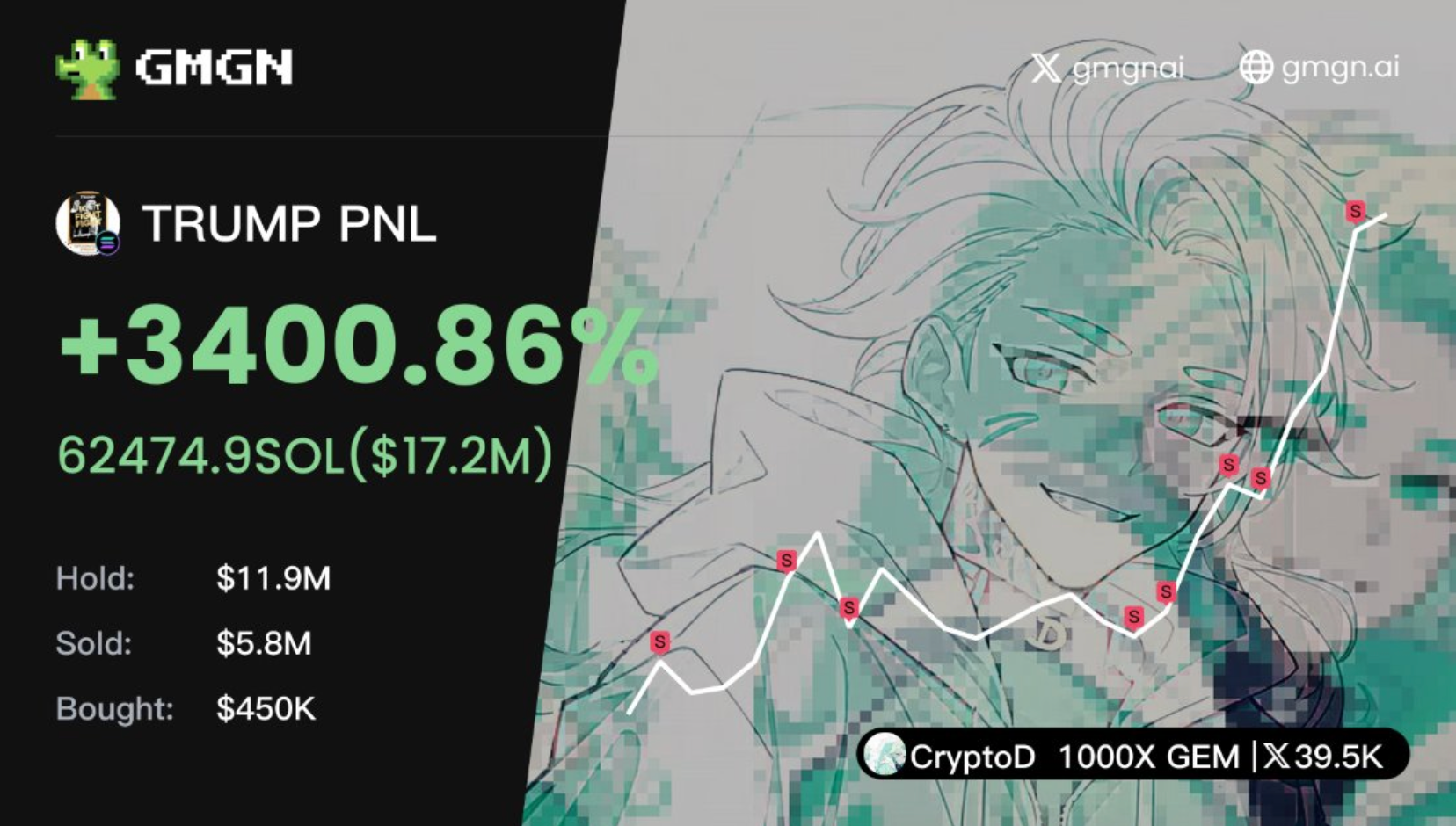
I saw this information as a catalyst and put my entire on-chain capital of $450,000 into $TRUMP. GMGN’s fast order execution ensured my buy went though flawlessly. I didn’t deposit additional funds because I was comfortable risking my $450,000. The rest, as they say, is history, as $TRUMP skyrocketed from 200 million to 70 billion market cap. I personally secured a profit of 17 million dollars.
0xSun
@0xSunNFT
One edge of on-chain analysis is that information is shared in a transparent and equitable way. The surprise issuance of the $TRUMP token with minimal market value wasn't possible under the traditional centralized system. This emphasizes the shift of influence toward on-chain protocols which are unlocking so much potential for the everyday investor.
The profits are tied to higher risks. Newer assets have more volatility. A keen ability to manage risk is a required skill. The nature of on-chain is unpredictable; do not blindly place high-risk bets.
My approach to trading is to avoid cutting losses. Instead, I'll rely on high profit earning assets to offset any risk. On-chain has a lot of potential for high returns, using a system and strategy will let you figure out what works best for you.
冷静冷静再冷静
@hexiecs
I use GMGN’s Pump.Fun board and wallet tracker to discover new tokens. First, I go to Twitter and other official resources to look into potential narratives. If promising, I look into the token holders to analyze the distribution. Large amounts of small wallets or associated wallet addresses signify a farm or a scam. When the distribution is organic and there are more individual users, and the valuation is reasonable, then I consider a trade. For early tokens, I generally aim to purchase at least 1% of the total supply. GMGN lets me buy in a single second, that’s very helpful for speed of execution. GMGN has token analysis tools that show the relationship between various wallets and their token holdings.
I rely on my experience and instincts to vet a good narrative which is why keeping up to date on market data is key. Many times you can waste a whole day looking for a token, but you need the practice. When $TRUMP came out, I noticed someone buying using GMGN wallet tracker. I then ran my analysis and bought. I also track the sell orders of those wallets I'm following, to better influence my own sell orders.
0xuezhang|985.eth
@Unipioneer
When I first saw Donald Trump's token, I questioned if it was hacked, given the initial market cap at that time. Realizing it was an opportunity, I quickly opened GMGN to find the pool. Then I invested my remaining 100 SOL for 33,998 $TRUMP which was by far my lowest cost share of position.
After, I gathered my thoughts and looked into community sentiment. Noticing others who I follow had also accumulated, I increased my position to 100k total at a range of 0.6-1.5 USD price point.
The price jumped to 2 USD, then dropped to 0.9 USD from a wave of FUD that it might not be Donald Trump. I cut some of my losses at this time, and later when official sources confirmed Donald Trump as the source of the token, everything grew from there.
We all know how it ends. $TRUMP listed on every major platform and I cleared half my position at 65 USD. I sold the rest of my bag when Melania also came out with a token at 58 USD, locking in 5 million USD in profit.
There are a few things I could have improved on. For example, I could have bought more after the official announcement by Trump, since the narrative was obvious. Thanks to GMGN I did not attempt any trades with my lowest cost shares and ended up with 2.2 million of that trade.
Yuyue
@yuyue_chris
I've been looking at GMGN data and trading since the early days of the platform. It was very lucky for me that I got in on $TRUMP because of it!
On chain analysis is one of the most important skills on-chain. I love how committed GMGN is to data analysis and that they're constantly updating it to serve every memecoin trader.
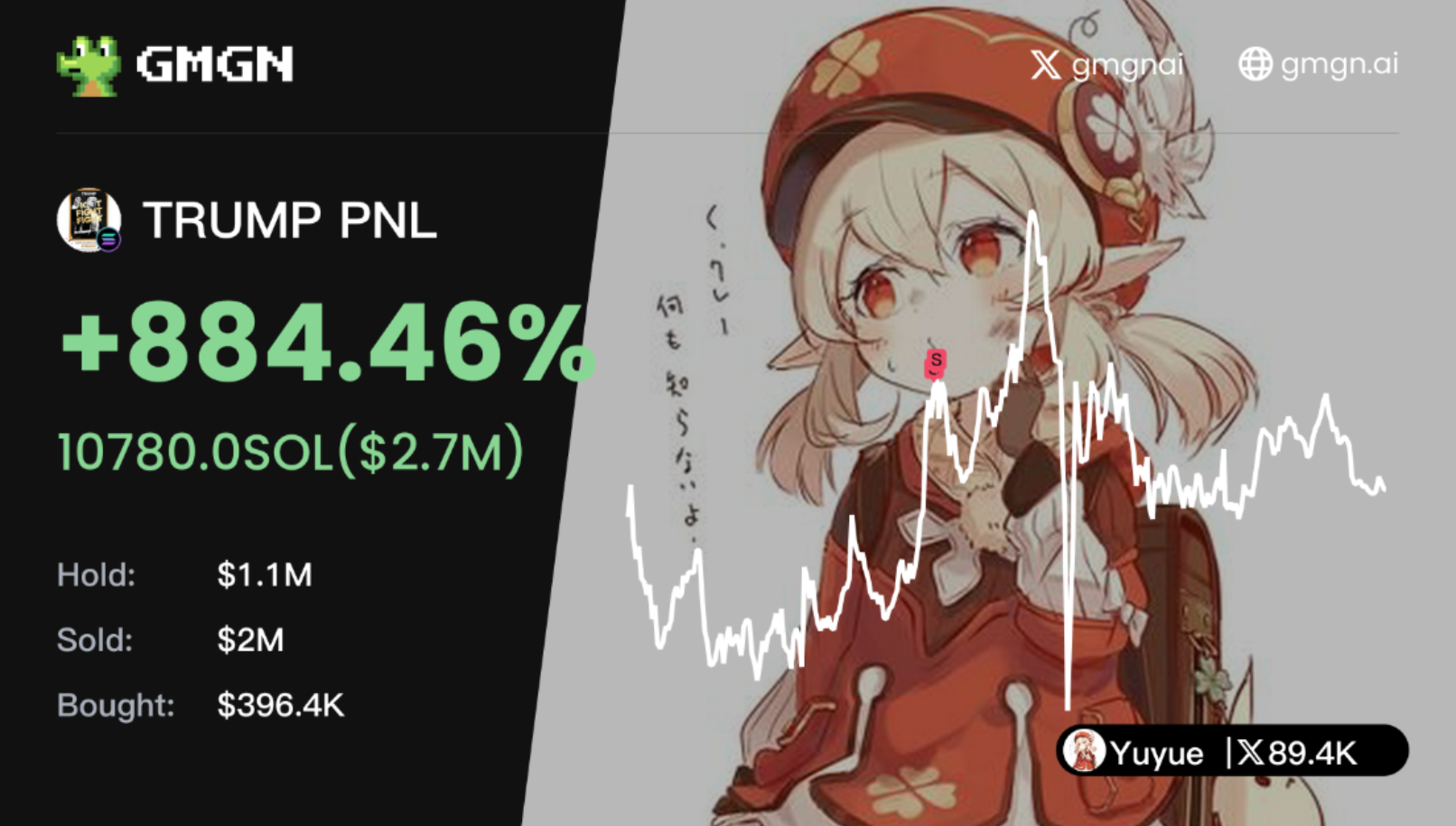
One of the only options to get into the early $TRUMP token was through GMGN, in part because of the way it operates to provide access with USDC routing with global node trading service. Not to mention, I even ended up on the $TRUMP most profitable address leaderboard! Tools are not everything, but having the right tool is key to your success; I think that the real era of on-chain assets and memes has only just begun.
JAMES (Monkey)
@corleonefnf
I'll share my day-to-day dog trading operation and ideas while I discuss $TRUMP. There are thousands of new tokens daily, so first you should ask yourself "Why am I buying right now and how far can this token go?" These questions will define how much capital you put and where you aim to take profit. For example, I woke up about 30 minutes after $TRUMP was issued, and I first looked into the circulating market cap and unlock schedule. I knew then, with a circulating supply of around 600 million, and a 3 month vesting schedule, it was a no-brainer.
Once the position was made, I removed all non-essential notifications to avoid any outside influence. I won't go into the entire trading process, but I made a comfortable profit of 4 million dollars. I'll share some tips from my experience.
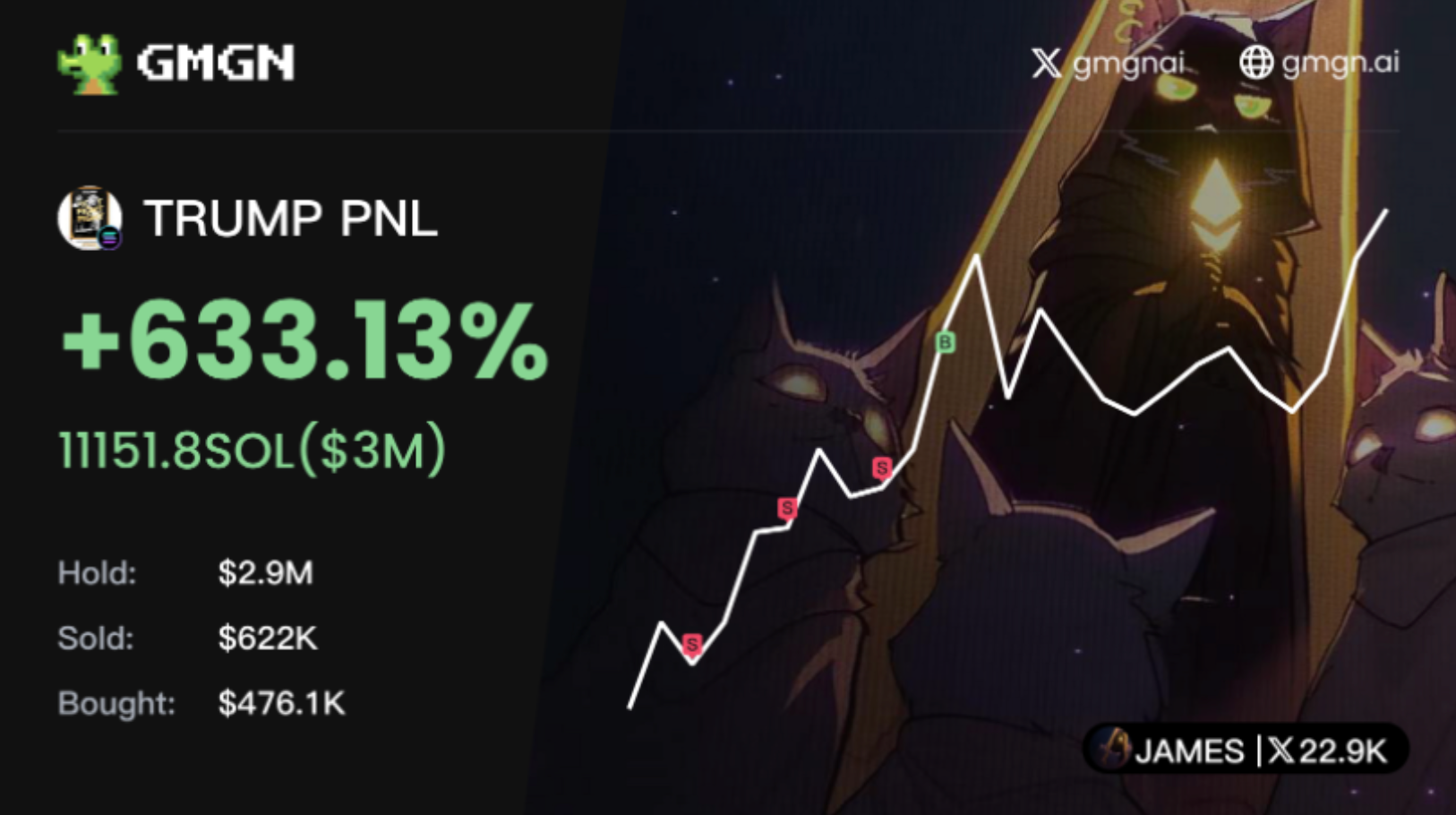
- I use GMGN's dashboard and trading features most often, with my attention going to the "Launched" section while focusing mostly on coins with a market cap over 100k. This ensures I am not focusing on early stage PVP trading. It allows me more time to analyze and uncover promising projects.
- When I see something I like, I'll go to token holders and check that. If GMGN flags the holders with small red wallets or the interactions between holders looks suspicious, I'll pass. GMGN will help you find those red flags quickly on the platform.
- There are two types of dog-coins: Meme coins and application coins (includes celebrity tokens)
A. For memes, I'm looking for one thing; if it makes me smile at first glance. It's a hit or miss with memes but this helped me find the 200 thousand market $LLM and the 3 million market cap $moodeng.
B. For application tokens, I use GMGN’s magnifying glass to find details on the team behind the project. Unlike Memes these projects are far different than memes as their early accumulation times tends to be shorter as everyone jockeys for accumulation at launch. Learning about the team's credentials and background will let you get large portions of the trade at lower prices. Use both GMGN tools combined with GROK or ChatGPT to summarize the dev’s past and track record. - During reviews, a great feature of GMGN is the ability for users to find the most profitable addresses at the front of the line for token purchases. By clicking into the addresses, GMGN can help you find all the relevant statistics of any address that help you better understand its trading style and frequency. Combine this with win rate metrics, and you can see potential leaders to copy in the future.
Finally review, deliberate, and try to be ahead of the competition are all key to success. Don't stress out and remember that opportunities are plenty in crypto. If you're going to treat this as a career, then put in the care and work this deserves, the future is yours.
大宇
@BTCdayu
The on-chain miracle plays in this round was the ability to make trades quickly. The decisions were made quickly and was a perfect storm of risk, capital, operations, and strategic thinking.
I saw the move when the price was 0.8 USD but it didn't take much time for me to analyze relevant info. For example, there was no large pool (tens of millions USD of locked liquidity); there was an uncertainty in relation to whether the account was hacked; and the official site had a credit card purchase option.
There was a similar phenomenon event in the past where there was an extremely large pool for some coin that rugged in 3 days, turning the price to zero. However there was a credit card option on the site and related software so I had the feeling it was relatively safe to play with. I decided to take a risk and put out the call to the community group: "Make a bet, for a 10x payout or to go to zero. if it’s not a direct rug then there’s a chance to get out." "If there was ever a reason to gamble, it was now."
Funny at the time, media were reporting FUD that the liquidity was only a few hundred SOL. The price went from 1 to 2 USD, and then back down to 1 USD. I decided to double-down at 1 stating "continue to play, you have to go big" As if on cue the official $TRUMP Twitter also tweeted and confirmed that this token was indeed real. All of this took place with a few minutes. It highlights the level of decision-making necessary in such a quick environment. If it wasn't for my system and analysis skills, the speed at which things were crashing meant it could have quickly become a massive loss. When I decided to buy I was using GMGN and my buys were processed nearly instantly. Either way it was an insane experience and there will be more moves.
Conclusion 🌕
Here we laugh, here we cry, here we live, here we "die".
MEME, MEME.
— GMGN.AI (🌞, 🌕)
Appendix: MEME Community Slang
- P-Soldier: Assets under $1M
- P-Captain: Assets between $1M - $5M
- P-General: Assets between $5M - $10M
- P-Marshal: Assets over $10M
- Front-runner: Refers to an address being monitored by most, whose trades heavily affect prices
- Pour on: Selling tokens on other to cause a sell-off
- It’s a wrap: An affirmation that signals certainty
- CA: Contract Address
- Sitting: Refers to sitting for hours analyzing chains and looking for trades
- On-Chain God: A trader with incredible skill and win rate who makes huge profits on-chain.
- Dummy King: A trader with a terrible trade history and very high losses.
- Cap: A joke about buying and seeing the price go down right away.
- PVP: Quickly buying low on a low cap and selling, with other traders as counter-parties.
- Trenches: Trading memecoins are super dangerous like fighting in trenches.
- Chain Scan: Continually looking at newly released tokens in search of trade opportunities.
- Angle: Memecoins are founded on hype and narrative, how to uncover value is called "finding the angle."
- Beast: The dev dumps their own token on holders
- Group Chat Member: Refers to the person who is pouring their tokens on you.
- Speed run: A project goes from 0 to 100 Million market cap in one day
- Archeology: The art of finding a “dead” meme-token and giving it new life with a new strategy
- PVP: Wealth transfers between users with a zero-sum result
- PVE: When everyone is profiting
- Old Timer: Someone who isn't involved in on chain trading
- Golden dog: A memecoin that everyone is profiting on
- Dog Token: General term for memecoin
- Dog Hunting: Trading memecoins.
- DEV: The person who launches the token.
- DS: Dev Sold, when the dev sells their token
- Project Team: Groups who carefully engineer memecoin scams
- Stuff: Buying Memecoins with SOL
- Empty: successfully selling and getting SOL back
- Group Chat Dev: A random person in a group chat who gives a CA with a catchy idea to "get everyone rich" and is the creator of the contract
- Floor: Refers to the first natural non-zero number in a price. Example, price is .00064 USD, now .00093. I got in on the 6th floor, and it’s now on the 9th floor.
- Sandwich: When a MEV bot buys before you (increasing your cost), and sells quickly after your purchase (limiting your potential). Protect yourself in GMGN by using anti-sandwich tools.
- FOMO: Fear of missing out and buying in
- FUD: Spreading bad news about a project
- GMGN, Good morning , Good night . 早安,晚安.
GMGN Official X: @gmgnai
GMGN Official Website: https://gmgn.ai
GMGN APP: https://gmgn.ai/app
More tutorials: https://docs.gmgn.ai/cn
